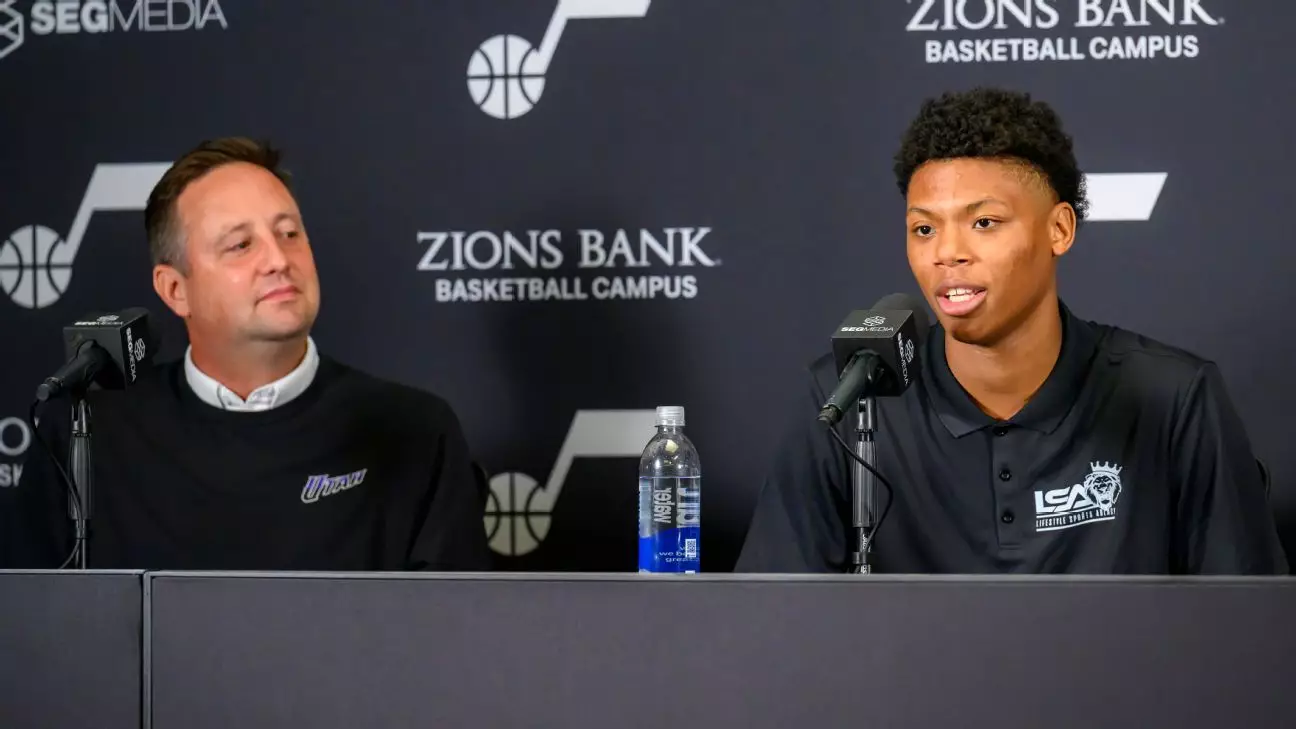Ace Bailey’s recent entry into the NBA with the Utah Jazz offers more than just a rookie’s hopeful story; it exposes a troubling narrative surrounding the NBA draft process and how young athletes are often scrutinized unfairly for attempting to control their own futures. Despite Bailey’s refusal to participate in workouts for several teams, a decision that drew public criticism, it’s clear that his focus remained firmly on harnessing his potential rather than engaging in the traditional pre-draft pageantry. This clash between player autonomy and organizational expectations casts a spotlight on the rigid structures within professional sports recruitment—structures that demand conformity at the expense of individual agency.
Bailey’s reluctance to showcase himself for every interested franchise was interpreted by many as unprofessional or indicative of attitude issues. However, this perspective oversimplifies the complexity of being a young athlete navigating a high-stakes business landscape. Rejecting workouts with specific teams is not necessarily a sign of arrogance but can be a calculated strategy rooted in personal or professional reasoning—especially when players have aspirations about where they best fit or want to cultivate their careers. The Jazz’s decision to draft him in the lottery despite his limited availability reinforces the idea that talent evaluation transcends rigid protocols; it’s the potential and character that ultimately matter.
The Utah Jazz’s Calculated Risk and Its Implications
Utah’s gamble on Bailey at No. 5, despite his unwillingness to participate fully in the pre-draft process, reveals a commendable willingness to look beyond traditional markers of compliance and see the bigger picture. Jazz president Austin Ainge’s remarks underscore a strategic vision: crafting a roster of versatile players who excel on both ends of the court and possess intangible character traits. This approach might signal a shift toward valuing multidimensional athletes who are not only skilled but bring an emotional and psychological resilience to the team dynamic.
Yet, this move is not without risk. Bailey slid from a consensus top-three projection down to fifth, fueled by concerns related to his efficiency, ballhandling, and defensive consistency. These concerns are valid in the basketball context—professional franchises invest heavily in assessing minute aspects of a player’s game. However, it’s worth questioning whether these technical critiques obscure the underlying issue of maturity and trust in player development. By publicly expressing confidence in his own work ethic and growth potential, Bailey challenges the notion that draft position and pre-draft behavior should stifle a player’s chance to prove himself at the next level.
The Pressure on Young Athletes: Expectations vs. Reality
Bailey’s statement that “God didn’t put us here to be perfect” resonates profoundly with anyone familiar with the transitional challenges faced by teenage athletes thrust into the spotlight. The NBA draft, after all, is as much a psychological battleground as it is a showcase of athletic skill. Young men like Bailey are expected to navigate media scrutiny, adapt to unprecedented professional demands, and reconcile their personal aspirations with the commercial interests of franchises often more focused on immediate results than long-term development.
This tension highlights an essential issue: the NBA and similar leagues must reconsider how they manage and support young athletes during these pivotal moments. Criticism aimed at players for managing their own exposure or negotiating terms implicitly assumes that the existing system functions fairly for all parties, which it often does not. The league’s competitive and commercial nature imposes a no-error margin on rookies, leaving little room for personal growth or error. Supporting emerging talent holistically rather than merely evaluating them on isolated technical drills or social media impressions should be a priority for improving the NBA’s culture moving forward.
Balancing Potential and Process: What the Jazz’s Approach Teaches Us
The Jazz’s draft decisions, centered on character and multifaceted skill sets, exemplify a healthier model for modern team building—one that could inspire other franchises to reevaluate their rigid adherence to traditional pre-draft procedures. Bailey’s journey indicates that while there are objective metrics to evaluate athletic potential, subjective assessments of leadership, resilience, and adaptability might be equally, if not more, important in determining a player’s future impact.
Moreover, this approach subtly pushes back against the corporate commodification of athletes, reminding us that players are not just assets to be traded or exploited but individuals with agency and evolving capacities. By investing in Bailey and his fellow rookies not only as scorers but as teammates capable of defensive and emotional contributions, the Jazz are making a statement about valuing human complexity within the high-pressure environment of professional sports.
In embracing this nuanced perspective, the NBA might begin to cultivate a more inclusive and empathetic culture—one where a player’s voice is respected as part of the equation, not sidelined as a disruptive anomaly. Ace Bailey’s story is not just about a draft pick landing in an unexpected city; it represents a call to rethink how talent is managed and how young athletes are empowered in a system too often defined by control rather than collaboration.


Leave a Reply